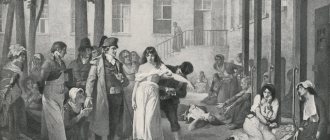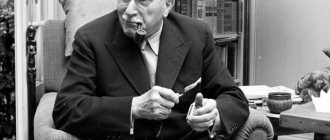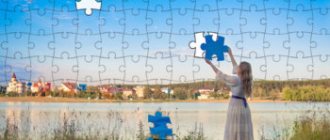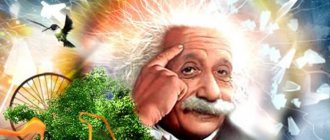Lecture 9
No matter how effective the method of dream analysis is, it is not the only practice in the Jungian tradition. In a normal situation, there is no method better than dream analysis, which allows you to understand what is happening in your deep unconscious, but in situations of an influx of unconscious contents into the waking consciousness, quicker measures are necessary.
This method is active imagination, which is very clearly distinguished from the passive fantasizing of a neurotic. Active imagination is a process that requires proper concentration and awareness.
Jung called active imagination “the Western analogue of yoga” and attached great importance to it. The difference between Jung's method and yoga and any other spiritual practices is very significant. In active imagination, we activate the unconscious and work with those images that are born spontaneously in our consciousness; whereas in almost any spiritual practice the main task is concentration on specific and predetermined images (which is also important for development and can be called directed imagination).
The first step of active imagination is to concentrate on the actual symptom. This could be fear, obsession, melancholy, or any other negative emotion. As we observe it, we gain power over it through the power of the logos, as we talked about in previous lectures. This concentration should lead to the fact that the symptom is formed into a certain image, which has its own specific described features. There are no instructions or prescriptions here - everyone’s unconscious produces its own symbols and images, which we will subsequently work with. In some cases, entire battles begin to play out in the imagination. As soon as we achieve personification of the symptom, it is easy to notice that the general tone begins to increase. This happens because the repressed energy, having had the opportunity to express itself through the image, was released and became more conscious. There was some relaxation.
However, this should not stop there. At the next stage, we actively interact with the emerging characters of our imagination. Under no circumstances should you try to artificially impose anything on them, otherwise the connection with actual images will cease, and active imagination will turn into passive fantasy. At the same time, it is necessary to try to reveal the image in as much detail as possible and, within the framework of an imaginary reality, work to ensure that the outcome is more positive. That is, in an imaginary situation, you should, as far as possible, try to react in the same way as you would react in the physical world. Jung gave the example of a young man who saw in his imagination that his fiancée was drowning, and did not react in any way to this. This approach is considered incorrect, because the difference between active imagination and sleep is the ability to influence the processes of the unconscious. In the practice of active imagination, it is necessary to avoid both extremes - both completely passive acceptance of an image (as in a dream), and the artificial introduction of images that are not related to the given dynamics. In the second case, artificially created images constructed by consciousness turn out to be dull and devoid of vitality, and the connection with the actual images of the unconscious is lost. It must be remembered that the unconscious fundamentally has its own version of the solution, and we need a fair amount of patience to find this solution.
The quote below gives the clearest and clearest statement of the essence of the method of active imagination: “Take the unconscious in the most suitable form (say, in the form of spontaneous fantasy, dream, strong emotion) and operate on it. Give it special attention, focus on it and objectively monitor the changes taking place. Dedicate all your energy to solving this problem, carefully observe the process of transformation of spontaneous fantasy. The most important thing is: don’t let anything from the outside world get into her, because she already has everything she needs” (Jung “MS”, par. No. 749).
Next I will give an example from my own practice. Three years ago, my paths completely diverged from those of my former teacher and analyst S.B., and he, wanting to prevent my further independent psychoanalytic activity, divulged some information about me, which, as I was sure, completely destroyed my reputation. The first moment I learned that he had violated the principle of non-disclosure of secrets obtained during psychological analysis, I experienced a shock. It seemed to me that I was sinking to the extreme depths of depression and hopelessness. Coming home from guests, I decided to try the active imagination method and concentrated on my feelings. A minute later, a picture appeared in front of my mind’s eye - a frozen winter lake and under a glass of ice - a drowned but still alive man, trying with his last strength to break through the ice. As soon as the first image appeared, I felt a little better. Then I focused on the picture and tried to introduce some positive images, in particular, I tried to call on Anima to pull him out from under the ice. However, any positive images looked superficial and unnatural - only the man under the ice had real expressiveness.
I did not calm down and continued to concentrate on this image. After about five minutes I felt a reluctance to work - this phenomenon is known in psychology as “resistance”, and since at that time I already had some ideas about psychological work, I overcame this feeling and continued to concentrate.
In this state, it is necessary to react as sensitively as possible to the hidden currents of the unconscious. And sure enough, after about ten minutes I felt a certain internal rhythm, like the measured blows of a blacksmith. Returning to the image, I discovered that it had changed, and now I saw a small circle of gloomy men in sheepskin coats, hitting huge hammers on the frozen ice. I was glad for the change and continued to concentrate. It seemed to me that now I could bring in my own images of salvation, but my imagination acted like a record stuck in one place - over the next ten minutes it played the same internal rhythm, which at some point even began to act on my spinal cord. the brain, hypnotizing with a single rhythm.
And only after ten minutes of intense attention did I finally achieve the next change in image - I saw a rescued person who was put on a sled, covered and wrapped in sheepskin coats and taken somewhere to the plane.
After finishing the session of active imagination, I noted with satisfaction that although nothing had changed objectively, my psychological state had increased by several points and reached a normal state. Even more - I felt some energy uplift: if I have to start all over again, I am ready for this, after all, the path that was traveled before is much more difficult, and with my current experience, starting from scratch will not be so difficult. As it turned out, this was not necessary, and the public disclosure of my complexes by my own analyst had virtually no effect.
I can confidently define this experience as a session of extremely correct practice of active imagination. However, now it's time to talk about what is not active imagination.
The biggest mistake, which Jung defined as “passive fantasying,” is self-narcotization with fantasy. That is, to indulge in beautiful and unrealistic fantasies, escaping reality. Remember - images of the imagination should always have character, be a reflection of the current state. If, upon arriving home, I began to indulge in pleasant fantasies about the death of Mr. S.B., then all I would get was the suppression of the conflict and withdrawal into fantasy.
In this chapter I find it necessary to talk in more detail about the dangerous side of the unconscious. In the Jungian tradition, it is customary to highlight, first of all, the positive aspect of the unconscious - as an endless source of energy and knowledge. However, this is only half the truth, which for real Jungians is balanced by knowledge of the dangerous side of the unconscious. For example, Edward Edinger, in The Creation of Consciousness, emphasized that the Self is often unconscious and needs the human ego to see itself in the mirror. In one of the previous lectures, we talked about all-connectedness, which can cause some delight in an unprepared person who assumes the absolute goodness of a single being. This illusion was actively supported by most of the early mystics. However, ultimate being is neither good nor evil, it simply stands on the other side of good and evil in its creative play, giving rise to both. The most successful analogy in world literature would be Lem’s “Solaris” - the power of the thinking planet that people encountered drove some to suicide, while the main character gave the opportunity for deep self-knowledge. All elements of existence, including evil, are included in this bizarre play of the one, located on the other side of any opposites.
Consciousness and the unconscious form an interacting dialectical pair, and how the unconscious will manifest itself in relation to it depends on the orientation of consciousness. It is necessary to know about the dangerous sides of interaction with the unconscious, because the path of individuation is the path of the lion, while the donkeys must remain chewing the thorns of traditional religions.
Completely different forces are hidden in the darkness of the unconscious, contact with which can lead to different results. Erich Neumann, in his excellent work "The Origin and Development of Consciousness," defined what consciousness has to confront as the "Great Mother" who wants to turn the ego back to the state of a dependent child. “A neurotic strives to return to childhood” - this is the formula for any shameful weakness of consciousness. Apparently, Aleister Crowley considered Jesus Christ a black magician for the insidious phrase “be like children,” which provides an excuse for various infantile sentimentality.
Having begun to interact with the unconscious, we must know that there we will have to meet a force that is aimed at returning us to childhood and abandoning the Ego. Here the Argo of our consciousness must sail between Scylla and Charybdis. “Take off your hat, bow, but don’t kneel” - this motto should become key for anyone who actively explores the depths of the psyche. The one who kneels instantly loses himself. You have probably met many representatives of various kinds of pseudo-occult organizations, observing which you get the feeling of some kind of two-dimensional plane of their mental life. In our circle, such creatures are defined as “castrates”, and, by the way, quite aptly. Turned back to childhood, he becomes deprived of sex, he does not have full-fledged passions, his sensuality is blurred, or even completely dissolved, and, it seems, his very being is deprived of plethora. Of course, a person who is completely obsessed with uncontrollable passions is not in a much better position than a “castrate”, but at least he still has the opportunity for ego development. Castrates are in the tenacious embrace of the maternal unconscious, so their further development is unlikely. Neumann, in The Origin and Development of Consciousness, considered castration emanating from the Great Mother as a symbol of the deprivation of consciousness and the destruction of the individual self. I think that Jung in the Tavistock Lectures, speaking about “heads with wings,” meant approximately the same thing.
We can determine how worthwhile a particular tradition is by its relationship to sexuality. Those who call for the “mortification of passions”, in fact, give an excuse to neurotics who are directed back to childhood. By the way, Aleister Crowley became disillusioned with the Order of the Golden Dawn and completely broke off all relations with it precisely because he felt a general anti-life attitude.
In the unconscious there is a force that can absorb, carry away to other worlds, depriving the slightest connection with the earthly (this danger was poetically superbly reflected by Brodsky in the poem “The Autumn Cry of a Hawk”), and this should never be underestimated. A truly strong master can allow himself to surrender to the flow, but usually this happens at very high levels of development. We must remember as an axiom: the task is not to escape into the worlds of the spirit, but to unite the spiritual and the material as much as possible.
What makes Jung's analytical psychology and Crowley's teachings of Thelema in common is the possible and feasible orientation toward the unification of opposites, which is the goal of individuation. Of course, in theoretical terms, this idea is not new: from Lao Tzu to Nicholas of Cusa, the highest Self was defined as the unification of opposite principles into a paradoxical unity, but only Jung and Crowley translated this mystery of unification into the sphere of practical application.
Active imagination is one of the most effective practices for uniting opposites, but the incorrect use of this technique leads to even greater regression. I observed a similar creature in the analysis of S.N. – one woman was unable to talk about her childhood complexes directly and used a huge set of protective symbolizations.
Without a doubt, when faced with a neurotic, you should not recommend the technique of active imagination; at first it is enough to limit yourself to the analysis of dreams and the most careful analysis of childhood with all Freudian and Adlerian motives. And only then, if he successfully passes this level, is it recommended to carefully proceed to active imagination.
Active imagination
Typically, these types of imagination are distinguished in psychology: active and passive. They differ not only in their internal content, but also in the main forms of their manifestation. Active imagination is the conscious construction of various images in your mind, solving problems and recreating connections between subjects. One of the ways it manifests itself is fantasy. For example, an author writes a script for a film. He invents a story based on real facts, which are embellished with fictitious details. The flight of thought can lead so far that in the end what is written turns out to be phantasmagoric and virtually impossible.
crime bosses)
A special manifestation of active imagination is a dream - the mental creation of images of the future. So, we often imagine what our house by the sea will look like, what car we will buy with the saved money, what we will name our children and what they will become when they grow up. It differs from fantasy in its reality and down-to-earthness. A dream can always come true, the main thing is to put all your efforts and skills into it.
Healing with Imagination
Psychologists say that the best way to become healthy is to imagine yourself as such. A thriving and vibrant image in our minds quickly becomes a real fact, and the disease recedes. This effect is described in detail by both medicine and psychology. The topic “Imagination and Its Impact on Oncology” was studied in detail by Dr. Cal Simonton, a leading cancer specialist. He argued that meditation and auto-training helped even those patients who were diagnosed with the last stage of the disease to recover.
The result amazed everyone: after a year and a half, some patients did not even have traces of the disease. Dr. Simonton is confident that positive images in our brain, will and desire can work real miracles. Imagination is always ready to be embodied in real form. Therefore, where there is war, it is worth imagining peace, where there are quarrels - harmony, where illness - health. Man has many hidden abilities, but only imagination gives us the opportunity to rise above all limitations, transcending space and time.
Passive imagination
Like other cognitive processes, imagination can be voluntary, that is, purposeful and regulated by our consciousness and volitional processes. But there is also involuntary imagination, which is associated not with conscious mental activity, but with the processes of the subconscious.
The degree of unconsciousness and involuntary imagination may vary. I think all of us have experienced a state when thoughts, images, ideas appear as if on their own, regardless of our desires. The thought freely “wanders in the convolutions” of the brain. Pictures and ideas pop up in your head; they are combined, modified, and evoke new associations. Sometimes at some stage we may become interested in a spontaneously arising thought and take control of the imagination process.
In such a situation, we are not only fully capable of controlling this mental process, but we also distinguish its images from the real ones, that is, we realize their fantastic nature. But there are other situations when the imagination is absolutely spontaneous, involuntary and passive, that is, the participation of images in any active activity is not even expected.
Passive involuntary imagination
This type of imagination includes dreams and hallucinations.
- Dreams are the product of a healthy psyche, their visions are the result of complex processes of excitation and inhibition in the cerebral cortex. Inhibition allows our subconscious, where a huge amount of figurative information is stored, to become more active. At the subconscious level, images intertwine and mix, giving birth to new combinations, like in a children's kaleidoscope. And such unusual pictures and intricate plots become the content of our dreams.
- Hallucinations, unlike dreams, are the result of painful conditions when brain activity is disrupted. This may be delirium during a serious illness, a consequence of alcohol and drug intoxication, or the result of mental disorders. Sometimes hallucinations occur in response to severe emotional shocks, when a person's level of rational control is sharply reduced.
Despite their differences, these two types of imagination are united by man's inability to control them. But there are types of passive, unproductive imagination that are completely conscious and controllable, although they often arise spontaneously and to a certain extent involuntarily.
Passive voluntary imagination
This type includes two very close and similar mental phenomena - dreams and reveries. One of the most important functions of imagination is predictive. Thanks to it, we can foresee developments in the future, not only probable, but also unlikely and even completely incredible. Why not? The power of our imagination is such that we are able to imagine anything: even a prince in a white Mercedes, even winning the lottery, even a dizzying success at work.
What is imagined does not always come true - there are not enough princes for everyone. But why not dream?
- Dreams are not just fantasies, but images of the desired future. They can be realistic to one degree or another, many of them require certain conditions and efforts for their implementation, but are quite achievable. And most importantly, even being a type of passive imagination, a dream encourages a person to be active.
- Dreams, unlike dreams, have no relation to reality; they are solely a product of our imagination, and, as a rule, a person does not even imagine doing anything to make dreams come true. This may be a pleasant, but illusory fulfillment of reality.
The boundary between a dream and a daydream is very fluid, sometimes it is difficult to notice, but the differences can be understood with a simple example. A girl, reading a book in the fantasy genre, imagines herself in the place of a heroine who finds herself in a fairy-tale world, where three princes or dark lords fall in love with her. It's a dream. And if a girl thinks that someday she will also write and even publish a similar book, then this is a dream. And with proper effort, it is quite feasible.
Properties and characteristics
V. Stern and D. Dewey were actively involved in the study of the properties and characteristics of imagination. They viewed it as an inherently human, “given” ability.
They understood the originality of imagination in its inherent properties:
- this is the mental exit of the individual beyond the limits of what he directly perceived and experienced;
- this is an image of the desired future or a “visible” result of a certain activity;
- This is an opportunity to “revive” and “replay” what happened.
According to the same researchers, imagination has the following characteristics:
- Brightness and clarity. They took it as an axiom that in children it is more vivid and original than in adults, because in the latter the flight of imagination is greatly limited by critical thinking.
- Realism. The degree of coincidence of imaginary images and ideas with reality.
- Controllability. The ability of consciousness to influence and control the course of the imagination process, changing certain parameters or general direction at the discretion of the person.
- Image activity level. The generally accepted point of view is that the more emotionally rich the images created, the more active they are. For example, the fear of a neurotic can completely “replace” what actually happened with an imaginary development of events. The degree of activity is the ability of images to be motives of activity and behavior, their regulators. The maximum motivating force is inherent in ideals and phobias, the minimum - in dreams and fantasies.
Imagination in psychology, the types of which do not have stable characteristics (even individual ones), is an objective reality. They vary greatly depending on how significant the image being created is for a particular person.
What do psychologists mean by imagination?
If we try to collect some kind of “arithmetic mean” from the definitions that various specialists in the field of psychology give to the imagination, then it can be described as a more or less controlled ability of the individual’s consciousness and subconscious to “construct” images, ideas, ideas, objects that they personally do not were perceived (or in principle could not be perceived) through the senses, and manipulate them.
In fact, this is the “base” for imaginative thinking - imagination provides a person with invaluable help when doing something in practice is impossible, problematic or impractical.
The first attempt to define the phenomenon was made by T. Ribot. The main thesis of his works is “to imagine is to depict.” Accordingly, imagination is the process of creating images, ideas and concepts, “reshaping” and “combining” one’s own experience and obtaining something completely new based on it.
Imagination in psychology (its types were not identified at first) was also interpreted by the first Russian researchers as a process. In their opinion, any process accompanied by the creation of images and mental control of them could be considered such. This point of view was held by A. Petrovsky and M. Yaroshevsky; among modern authors, V. Kazakov and L. Kondratieva continue to share it.
Further, a very “vague” definition was narrowed and specified in the works of M. Gamezo and I. Domashenko. They understood imagination as the process of creating new images and ideas taking place in the psyche on the basis of evaluating and processing previous experience.
Later, interpretations of imagination as an ability (V. Kudryavtsev), specific activity of the nervous system (B. Teplov, L. Stolyarenko) appeared.
Taking into account the complexity of its functioning, L. Vygotsky even spoke of a “psychological system” in which imagination is inextricably linked with thinking and emotions
The original idea was expressed by E. Ilyenkov, according to whom, the described process is only a “derivative”, a “side effect” of the imagination itself. And its essence is the ability to see reality with the eyes (that is, the body’s ability to create an image of an object from the surrounding reality on the surface of the retina). The author of the hypothesis considers imagination as an optical phenomenon.
Recently, the “focus” of research on this phenomenon has shifted somewhat. Particularly relevant is the study of the essence of creativity, the search for principles and diagnostic methods that make it possible to identify and develop appropriate abilities in children at an early age. Among the specialists involved in this, we can note A. Brushlinsky, A. Ponomarev, V. Krutetsky, A. Petrovsky.
Among foreign specialists, a huge contribution to the development of the phenomenon of imagination was made by J. P. Guilford, who, in fact, is the creator of the psychology of creativity. He replaced the term “imagination” with the words “divergent thinking,” by which he meant the creation of new, original and unique ideas, the main purpose of which is self-expression. This type of thinking is fluent, flexible, and accurate.
From the point of view of physiologists, imagination is the actualization, regrouping and disintegration of neuronal connections, the creation of new systems from them. As a result, images appear that are not the lived experience, but are closely related to it.
The complexity, spontaneity and unpredictability of the phenomenon, its connection with the emotional sphere gives reason to believe that the process occurs not only in the cerebral cortex, but also in the hypothalamic-limbic system.
Psychology of imagination and its possibilities
Each of us has many hidden abilities. They are suppressed by many restrictions. The power of imagination allows us to cope with them - to overcome time and space, laziness and apathy, inertia and prejudices. Without it, many things in our lives would be impossible, including:
• get to know yourself and the world around you with the help of vivid images and various manipulations with them;
• achieve emotional release, including during meditative training, for example, when performing the practice of gaining energy;
• regulate relationships with people: convince them, influence their decisions, eliminate conflicts;
• achieve better health through relaxation therapy;
• enjoy the work of great artists, composers, writers.
The power of imagination is capable of transforming reality beyond recognition. Of course, much depends on the direction of this force. Let's not forget about the harm of fruitless illusions and sick fantasies, obsessions and delusional thoughts.
But let us remember that imagination is a great gift that made the upright primate the crown of nature
According to Anatole France, it can turn a sensitive person into an artist, and a brave person into a hero. And according to Denis Diderot, without imagination there can be neither a thinker, nor a poet, nor just a person
How Imagination Manifests
Depending on the type of imagination, it manifests itself in different forms.
For active imagination it is:
- Thought experiment. Characteristic mainly for scientists. It is believed that Aristotle was the first to “conduct” such experiments, and Galileo widely popularized them. In the absence of opportunities to conduct an experiment in reality, this is the only behavior option for someone who wants to predict the result of their own actions.
- Fantasy. Has nothing to do with reality. It will not be possible to bring it to life simply because the objects that you can fantasize about do not exist in reality. But the result could be, for example, a science fiction novel.
- Dream. A clear image of what you want, what you can get in reality. It can be both useful and harmful. In the first case, it is an incentive to take action aimed at achieving it; in the second, it is a tendency to “hover in the clouds” without doing anything useful.
Passive imagination manifests itself as:
- Dream. It is generated by a healthy psyche. Reflects an emotional attitude to the experience. Other options for their interpretation are the “translation” of information from operational to long-term memory or the satisfaction of subconscious needs.
- Hallucination. Typically for a awake person with mental disorders, or under the influence of alcohol, drugs, or psychotropic substances. It is not reality, but it is perceived as such.
- Dream. It differs from a dream in that it has little or no relation to objective reality. This is a pleasant but illusory alternative to reality.
Accordingly, a person’s lack of imagination means for him the complete impossibility of any progress.
Purpose and functions
The role of imagination is represented by the following points:
- the ability to represent reality using images, the ability to use them;
- in an unforeseen event, an individual can form a plan of action;
- the ability to regulate the emotionality of relationships;
- regulation of individual cognition processes.
Imagination allows one to go beyond the limits of human understanding, helps to foresee the future, and brings the past to life.
I bring to your attention the functions of imagination.
- Encouraging active activity with the help of an attractive, vivid image of the result.
- The presence of certain plans and ways of implementing plans.
- Psychotherapy, emotional self-regulation, illusory satisfaction of one's needs. Based on this feature, there is a risk of losing reality. A particular example of replacing reality with images from games, a consequence of gambling addiction.
- The ability to regulate one’s behavior in non-standard situations, sometimes problematic, with the help of alternative actions, new images, taking into account possible consequences.
- Organization of cognition, modeling, reconstruction of objects according to a detailed description, completion of missing elements.
Passive
Passive (involuntary) imagination means the emergence of images that does not require conscious effort from a person.
With weakened conscious control, they arise by themselves, without a person’s volitional effort.
The source of their occurrence is not a logical connection and a person’s awareness of reality.
The passive images that arise often serve as a reflection of his internal state, fears, aspirations, desires, and speak about the personal needs of the individual.
Involuntary imagination is often not subject to logical comprehension, often representing a combination of completely contradictory images.
It is also often difficult to verbalize it after the experience, since such images are often symbolic, abstract and incomprehensible to other people.
Passive imagination is governed by two basic principles:
- Each affect strives to be preserved by exaggerating the subjective logical value of ideas. Thus, a cheerful person will more often have positive images, and a sad person, on the contrary, will have sad ones.
- A person strives to preserve pleasant experiences, and, therefore, pleasant images that arise.
Often passively arising images are not tied to time. Thus, the person observing them also loses the sense of time.
Subspecies
Passive imagination is divided into two subtypes:
- unintentional. Includes hallucinations, dreams and daydreams. They arise on their own, without the volitional participation of a person;
- intentional - hypnotic states caused by another person.
Description
- Dreams.
On the scale of voluntariness, they occupy the position furthest from awareness. Often in dreams we see bizarre images and strange plots. Nevertheless, they are important for the regulation of a person’s psycho-emotional state, since they are not only echoes of what a person has previously heard and seen, but also represent material that has been very deeply processed by the psyche. - Dreams. Dreams, like daydreams, are often a departure from reality, with the difference that dreams are aimed at the future, and daydreams replace the present. For example, a schoolboy who is offended by his comrades may imagine how he takes revenge on the offenders. In this case, the emerging images will represent an alternative reality, bringing the student some satisfaction, but at the same time leading him away from the real state of affairs.
Hypnotic states. The deeper the hypnotic trance, the less attention a person pays to external stimuli, the less real reality means to him. The subjective sense of time may also change, and negative hallucinations may arise - when a person does not see real objects. Only the connection with the hypnotist inducing the trance is maintained. Hypnotic trance is quite often used in psychotherapy.
Hallucinations. Hallucinations usually occur in people with congenital physiological brain damage, as a result of traumatic brain injury, viral infections, and the use of psychotropic substances. Often perceived as genuine reality.









